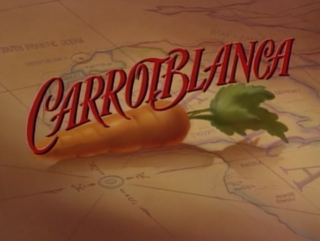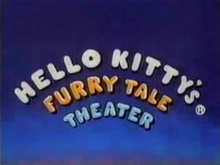
Looney Tunes is an American animated franchise produced and distributed by Warner Bros. It began as a series of short films that originally ran from 1930 to 1969, along with its partner series Merrie Melodies, during the golden age of American animation. Following a revival in the late 1970s, new shorts were released as recently as 2014. The two series introduced a large cast of characters, including Bugs Bunny, Daffy Duck, and Porky Pig. The term Looney Tunes has since been expanded to also refer to the characters themselves.

Hello Kitty, also known by her real name Kitty White, is a fictional character created by Yuko Shimizu, currently designed by Yuko Yamaguchi, and owned by the Japanese company Sanrio. Sanrio depicts Hello Kitty as an anthropomorphized white cat with a red bow and no visible mouth. According to her backstory, she lives in a London suburb with her family, and is close to her twin sister Mimmy, who is depicted with a yellow bow.

Wile E. Coyote and the Road Runner are a duo of cartoon characters from the Looney Tunes and Merrie Melodies series of animated cartoons, first appearing in 1949 in the theatrical cartoon short Fast and Furry-ous. In each episode, the cunning, devious and constantly hungry coyote repeatedly attempts to catch and subsequently eat the roadrunner, but is always humorously unsuccessful in doing so. Instead of his instinctive animal abilities, the coyote uses absurdly complex contraptions to try to catch his prey. They comically backfire, with the coyote often getting injured in slapstick fashion. Many of the items for these contrivances are mail-ordered from a variety of companies implied to be part of the Acme Corporation. TV Guide included Wile E. Coyote in its 2013 list of "The 60 Nastiest Villains of All Time."

Sylvester J. Pussycat Sr. is a fictional character, an anthropomorphic cat in the Looney Tunes and Merrie Melodies series of cartoons. Most of his appearances have him often chasing Tweety Bird, Speedy Gonzales, or Hippety Hopper. He appeared in 103 cartoons in the golden age of American animation, lagging only behind superstars Bugs Bunny, Porky Pig, and Daffy Duck. Three of his cartoons won Academy Awards, the most for any starring a Looney Tunes character: they are Tweetie Pie, Speedy Gonzales, and Birds Anonymous.

Droopy is an animated character from the golden age of American animation. He is an anthropomorphic white Basset Hound with a droopy face; hence his name. He was created in 1943 by Tex Avery for theatrical cartoon shorts produced by the Metro-Goldwyn-Mayer cartoon studio. Essentially the polar opposite of Avery's other MGM character, the loud and wacky Screwy Squirrel, Droopy moves slowly and lethargically, speaks in a jowly monotone voice, and—though hardly an imposing character—is shrewd enough to outwit his enemies. When finally roused to anger, often by a bad guy laughing heartily at him, Droopy is capable of beating adversaries many times his size with a comical thrashing.

The Twisted Tales of Felix the Cat is an American animated television series produced by Film Roman. The series first aired on September 16, 1995 on CBS Saturday mornings lasting for two seasons with the final episode airing on April 12, 1997. The first season consists of 13 episodes and the second and final season consists of 8 episodes.

The Bugs Bunny Show is a long-running American animated anthology television series hosted by Bugs Bunny that was mainly composed of theatrical Looney Tunes and Merrie Melodies cartoons released by Warner Bros. between 1948 and 1969. The show originally debuted as a primetime half-hour program on ABC in 1960, featuring three theatrical Looney Tunes cartoons with new linking sequences produced by the Warner Bros. Cartoons staff.

Bubsy is a series of platforming video games created by Michael Berlyn and developed and published by Accolade. The games star an anthropomorphic bobcat named Bubsy, a character that takes inspiration from Super Mario Bros. and Sonic the Hedgehog. The games were originally released for the Super NES, Mega Drive/Genesis, Game Boy, Jaguar, PC and PlayStation during the 1990s.

Looney Tunes Golden Collection: Volume 1 is a DVD box set that was released by Warner Home Video on October 28, 2003. The first release of the Looney Tunes Golden Collection DVD series, it contains 56 Looney Tunes and Merrie Melodies cartoons and numerous supplements. The set won the Classic Award at the Parents' Choice Awards.
This is a complete list of the 166 shorts in the Tom and Jerry series produced and released between 1940 and 2021. Of these, 162 are theatrical shorts, one is a made-for-TV short, one is a two-minute sketch shown as part of a telethon, and two are special shorts released on HBO Max.

The Bugs Bunny/Road Runner Movie is a 1979 American animated comedy package film directed by Chuck Jones, consisting of a compilation of classic Looney Tunes/Merrie Melodies shorts and newly animated bridging sequences hosted by Bugs Bunny. The bridging sequences, which had been produced in 1978, show Bugs at his home, which is cantilevered over a carrot-juice waterfall. The film was released to celebrate the 40th anniversary of Bugs Bunny.

Carrotblanca is a 1995 Looney Tunes cartoon short. It was originally shown in theaters alongside The Amazing Panda Adventure and The Pebble and the Penguin (internationally). It was subsequently released on video packaged with older Looney Tunes cartoons and was included in the special edition DVD, and later HD DVD, Blu-ray and iTunes, releases of Casablanca, the film to which it is both a parody and an homage.

Sean Brené Roberge was a Canadian actor.

Spike and Tyke are fictional characters from the Tom and Jerry animated film series, created by William Hanna and Joseph Barbera. Spike is portrayed as an English Bulldog, who is generally amiable and friendly, and a loving father to his son Tyke in several episodes. However, Spike's character also has a very stern, and fierce side, for occasions such as when he is defending his son Tyke.

Bugs Bunny's 3rd Movie: 1001 Rabbit Tales is a 1982 animated comedy film by Friz Freleng. It combines classic Warner Bros. cartoon shorts with new animation, with Bugs Bunny serving as the story host.
Events in 1948 in animation.
Events in 1946 in animation.
Gabby's Dollhouse is an American live-action/computer-animated preschool interactive television series created by Blue's Clues veterans Traci Paige Johnson and Jennifer Twomey for Netflix which first premiered on January 5, 2021. In the series, Gabby and her cat friends called the Gabby Cats go on adventures inside the dollhouse.














